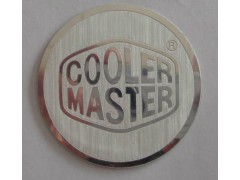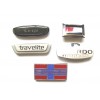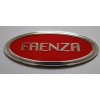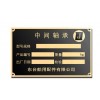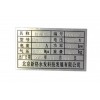China Name Plate Manufacturers,we custom name plates,brass plate engraving.
Material:metal,Aluminum,Anodized Aluminum,Brass,Stainless Steel,Polycarbonate,Polyester,Vinyl.
Overlap, you can achieve the purpose of positioning.
3, metal printing plate ink formulation. metal plate with silk screen printing ink demand is strong adhesion, good wear resistance after printing graphics clear, fast drying and without censorship. A metal plate screen printing oil
As is the use of alkyd, phenolic and other synthetic resin as binders, adding some pigments, additives made of special ink. Preferably this ink printability, and air-dried at 120 ℃ print conditions
Bake 2 hours to dry. Its bright surface of the ink film, three-dimensional, with excellent adhesion and wear resistance of the aluminum plate. This ink ink film with JM-l-type abrasion tester to test the film, 7509's Load
Rubber wheel grinding pressure up to 500 times with a cloth round grinding up to 5000 times.
If the screen color signs, reference may be colored with ink printing ink color samples related transfer ink should add the right amount of varnish and desiccant. Ink drying agent added is about 5 to 8% of the total ink, plus less
Easy to dry, plus much more affected the adhesion of the inks.
4, the quality of the metal printing plate requirements. Signs silk screen text, scale, graphics, and color should be consistent with the positioning hole drawings, finished surface should be no scratches, stain adhesion, ink film should
Meet the requirements.
Analysis of technological features and name signs
In various nameplate production, often require different types of guests encountered signs (also known nameplate). Type and process signs there are many, here are some common signs of its technological features to make a
brief introduction.
The first is a screen printing plate, metal-printing signs, plastic screen printing plate, acrylic silk screen signs. Screen printing plate having a very wide range of adaptability, and more for plastic panel above, such as speaker panel, machine
Box panel and some other mechanical panels. Low cost, wide application characteristics.
?
The second is the offset printing plate. In a round of flattened printing, graphic plane parts from the rubber roller transferred, graphic fine, commonly used in the table, such as licensing.
?
The third is a printing plate. Photo silicone head adsorption using ink on the intaglio, transferred to the workpiece, the change is more suitable for uneven surfaces, such as arc and so on.
?
The fourth is a transfer plate. Photo prefabricated on the transfer paper to facilitate operations at the site of the workpiece. Transferring a pattern is very clear, but the corresponding terms, the production cost is also higher.
The fifth is an electrophoretic plate. In the DC electric field makes with the polar liquid paint deposited on bare metal surfaces, often used in conjunction with the etching process.
The sixth is electroforming signs. A larger current density, the metal is deposited in the "female", the deposition and later with the parent-peel. Ultra-thin self-adhesive electroforming nameplate belongs to this type, is widely popular in recent years,
A species.
?
Seventh plating plate. Material may be other metal and plastic. After etching graphic, depositing metal ion, typically chromium, nickel, gold. Signs plating surface is very bright, is very noble, but also anti-
Corrosive.
The eighth is the high light signs. Generally convex surface of the aluminum pressed to diamond rotary knife cutting, resulting in high gloss. It is a relatively affordable nameplate production.
The ninth is a crystal Disu signs. This is a follow-up to finishing processing, transparent polyurethane infusion in good surface signs, decorative and protective effect. Intermediate Disu signs generally slightly raised
, Surface smooth and bright, widely used in electronics, home appliances, electrical and other machinery industry products above.
?
The tenth is soft PVC plastic signs. Is a polycarbonate (PC or PVC) as the substrate, through the mold hot injection molding, then painted or vacuum plating subsequent processing such as color and pattern to complete signage protection

